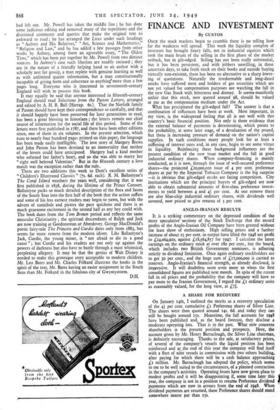Selected Reprints
THE Cresset Press has done good service to literature by undertaking the publication of the series of reprints supervised by Mr. John . Hayward' under the title of the Cresset Library. These volumes are admirably printed and bound and very moderately priced. The last, which appeared, in February, was a carefill edition by Mr. J. E. Morpurgo of Leigh Hunt's Autobiography. And now this week come two further vohimes which undoubtedly deserve to be made accessible—James Mclitier's The Adventures of Hajji Baba of Ispiihan and Brief Lives and Other .Selected Writings by John Aubrey (9s. 6d. each). Moder died on March 19th, 1849Celebrations of .his centenary have been few. He was, as Mr. Richard Jennings points out in an excellent introduction, " the' man of one immortal book." To modern eyes Hajji Baba appears as a mixture of the Arabian Nights and Flecker's Hassan with a strong dash of Kai Lung (indeed it is hard to believe that Ernest Bramah was not influenced by Morier): The itithor was a diplOrnat and traveller who knew the - Orient well ; his book is the autobiography of a handsome rogue Who lived on his wits, sand its publication in 1824 unclerstandaWannoyed the Persians. But there -was probably more truth in it than fiction; the story of the unfortunate slave-girl Zeenab has a genuine pathos, the gruesome detail somehow induces a fatalistic acceptance rather than disgust, and Morier abundantly proves that oriental ruthlessness and cynicism can make an enjoyable diversion.
Mr. Anthony POivell's edition of Aubrey's Brief Lives sets the sear on his rehabilitation, of that rewarding seventeenth-century scholar and gossip which he began by the publication of his authoritative biography last Christmas. Aubrey was a pioneer of English biO- graphical writing, and a careful, well-arranged edition such as this, designed,primarily for the reader's convenience, has been long over- due. Andrew Clark's elaborate edition of 1898 is indispensable as a record but very difficult to read ; while Mr. John Collier's selection of 1931, though naturally entertaining enough, distorted the picture- of Aubrey by concentrating on the salacious paisage§-Virieli Clark had left out. Mr. Powell has taken the middle line ; he has done some judicious editing and removed many of the repetitions and the disjointed comments and queries that make the original text so awkward to read ' • he has arranged the Lives under such headings as " Aubrey and His Relatives," " Art, Science and Mathematics," " Religion and Law," and he has added a few passages from other works by Aubrey, among them an agreeable essay, " The Olden Time," which has been put together by Mr. Powell from two distinct sources. In Aubrey's case such liberties are readily excused ; they are in the nature of a friendly helping hand to an author with a scholarly zest for gossip, a man replete with genuine learning as well as with unlimited quaint information, but a man constitutionally incapable of giving form and coherence to anything more than a few pages long. Everyone who is interested in seventeenth-century England will wish to possess this book. It may equally be said that anyone interested in fifteenth-century England should read Selections from the Paston Letters, arranged and edited by A. H. R. Ball (Harrap. 6s.). That the Norfolk family of Paston should have kept their correspondence so carefully, and that it should happily have been preserved for later generations to read, has been a great blessing to historians ; the letters remain our chief source of information for the social life of this period. Some of the letters were first published in 1787, and there have been other editions since, one of them in six volumes. In the present selection, which runs to nearly four hundred pages printed on thin paper, the language has been made easily intelligible. The love story of Margery Brews and John Paston has been destined to an immortality that neither of the lovers could have anticipated. Margery had a kind mother who softened her father's heart, and so she was able to marry her "right well beloved Valentine." But in the fifteenth century a love match was the exception rather than the rule.. There are two additions this week to Dent's excellent series of " Children's Illustrated Classics " (7s. 6d. each). R. M. Ballantyne's The Coral Island weathers the years well, considering that it was first published in 1858, during the lifetime of the Prince Consort. Ballantyne packs so much detailed description of the flora and fauna of the South Seas into the first half of the book that the action suffers and some of his less earnest readers may begin to yawn, but with the advent of cannibals and pirates the pace quickens and there is as much gruesome excitement in the second half as any boy could wish. The book dates from the Tom Brown period and reflects the same muscular Christianity ; the spiritual descendants of Ralph and Jack are now training at Gordonstoun or Aberdovey. George MacDonald's poetic fairy-tale The Princess and Curdie dates only from 1883, but seems far more remote from the modern idiom. Like Ballantyne's Jack, Curdie, the young miner, is " not afraid to die in a good cause " ; but Curdie and his readers are not only up against the powers of darknesi but also have to battle through a most whimsical, perplexing allegory. It may be that the genius of Walt Disney is needed to make this grotesque story acceptable to modern children. Mr. Leo Bates and Mr. Charles Folkard illustrate the books in the Spirit of the text, Mr. Bates having an easier assignment in the South Seas than Mr. Folkard in the fabulous city of Gwyntystorm.



































 Previous page
Previous page